Belkin F7D1101V1 Belkin Wireless USB Adapter User Manual
Belkin International, Inc. Belkin Wireless USB Adapter
Belkin >
User Manual

Basic
Wireless UsB AdApter
User Manual
F7D1101v1 8820-00382
TABLE OF CONTENTS
Introduction ...............................................1
Benefits of a Home Network.................................... 1
Advantages of a Wireless Network .............................. 2
Placement of your Wireless Networking Hardware for Optimal
Performance................................................. 3
Overview..................................................7
Product Features ............................................ 7
Applications and Advantages .................................. 8
Product Specifications ........................................ 9
System Requirements........................................ 11
Package Contents ........................................... 11
Installing and Setting up the Adapter........................12
A. Installation Process for Windows Vista and 7 .................. 12
B. Installation Process for Windows XP ......................... 20
Connecting to a Secure Wi-Fi® Network ........................ 24
Troubleshooting ......................................... 25
Technical Support ........................................... 31
Information.............................................. 32
FCC Statement.............................................. 32
Belkin International, Inc., Limited 2-Year Product Warranty .........34

1
INTRODUCTION
Thank you for purchasing the Belkin Basic Wireless USB Adapter.
Now you can take advantage of this great new technology and gain
the freedom to network your home and office computers wirelessly.
This Adapter allows you to connect a notebook or desktop computer
to your network. Please be sure to read through this User Manual
completely, and pay special attention to the section titled, “Placement
of your Wireless Networking Hardware for Optimal Performance.”
Benefits of a Home Network
Your Belkin Home Network will allow you to:
• Share one high-speed Internet connection
with all the computers in your home
• Share resources, such as files, and hard drives among
all the connected computers in your home
• Share a single printer with the entire family
• Share documents, music, video, and digital pictures
• Store, retrieve, and copy files from one computer to another
• Simultaneously play games online, check Internet email, and chat

2
INTRODUCTION
Advantages of a Wireless Network
• Mobility – you’ll no longer need a dedicated “computer
room”—now you can work on a networked laptop or
desktop computer anywhere within your wireless range
• Easy installation – Belkin Easy Installation
Wizards make setup simple
• Flexibility – set up and access printers, computers, and
other networking devices from anywhere in your home
• Easy expansion – the wide range of Belkin networking
products let you expand your network to include
devices such as printers and gaming consoles
• No cabling required – you can spare the expense and hassle
of retrofitting Ethernet cabling throughout the home or office
• Widespread industry acceptance – choose from a
wide range of interoperable networking products

3
INTRODUCTION
Placement of your Wireless Networking
Hardware for Optimal Performance
Your wireless connection will be stronger the closer your computer
is to your wireless router (or access point). Typical indoor operating
range for your wireless devices is between 100 and 200 feet. In the
same way, your wireless connection and performance will degrade
somewhat as the distance between your wireless router (or access
point) and connected devices increases. This may or may not be
noticeable to you. As you move farther from your wireless router
(or access point), connection speed may decrease. Factors that
can weaken signals simply by getting in the way of your network’s
radio waves are metal appliances or obstructions, and walls.
If you have concerns about your network’s performance that might
be related to range or obstruction factors, try moving the computer
to a position between five and 10 feet from the wireless router (or
access point) in order to see if distance is the problem. If difficulties
persist even at close range, please contact Belkin Technical Support.
Note: While some of the items listed below can affect network
performance, they will not prohibit your wireless network from
functioning; if you are concerned that your network is not operating
at its maximum effectiveness, this checklist may help.

4
INTRODUCTION
1. Placement of your Wireless Router (or Access Point)
Place your wireless router (or access point), the central
connection point of your network, as close as possible
to the center of your wireless network devices.
To achieve the best wireless network coverage for your “wireless
clients,” (i.e., computers enabled by Belkin Adapters or Cards):
• Ensure that your wireless router’s (or access point’s)
antennas are parallel to each other, and are positioned
vertically (toward the ceiling). If your wireless router (or
access point) itself is positioned vertically, point the
antennas as much as possible in an upward direction.
• In multistory homes, place the wireless router (or access point) on a
floor that is as close to the center of the home as possible. This may
mean placing the wireless router (or access point) on an upper floor.
• Try not to place the wireless router (or access
point) near a cordless 2.4GHz phone.
2. Avoid Obstacles and Interference
Avoid placing your wireless router (or access point) near devices
that may emit radio “noise”, such as microwave ovens. Other
objects that can inhibit wireless communication can include:
• Refrigerators
• Washers and/or dryers
• Metal cabinets
• Large aquariums
• Metallic-based, UV-tinted windows
• Microwaves
If your wireless signal seems weak in some spots, make sure
that objects such as these are not blocking the signal’s path
between your computers and wireless router (or access point).

5
INTRODUCTION
3. Cordless Phone Placement
If the performance of your wireless network is impaired after
attending to the above issues, and you have a cordless phone:
• Try moving cordless phones away from the wireless router
(or access point) and your wireless-enabled computers.
• Unplug and remove the battery from any cordless phone that
operates on the 2.4GHz band (check manufacturer’s information).
If this fixes the problem, your phone may be interfering.
• If your phone supports channel selection, change the channel
on the phone to the farthest channel from your wireless network
as possible. For example, change the phone to channel 1 and
move your wireless router (or access point) to channel 11.
(Your channel selection will vary depending on your region.)
See your phone’s user manual for detailed instructions.
• If necessary, consider switching to a
900MHz or 5GHz cordless phone.
4. Choose the “Quietest” Channel for your Wireless Network
In locations where homes or offices are close together, such
as apartment buildings or office complexes, there may be
wireless networks nearby that can conflict with yours. Use the
Site Survey capabilities of your Belkin Wireless Networking
Utility to locate any other wireless networks, and move
your wireless router (or access point) and computers to a
channel as far away from other networks as possible.
Experiment with more than one of the available channels in
order to find the clearest connection and avoid interference
from neighboring cordless phones or other wireless devices.
For more Belkin wireless networking products,
use the detailed Site Survey and wireless channel
information included in your User Manual.

6
INTRODUCTION
5. Secure Connections, VPNs, and AOL
Secure connections typically require a user name and password, and
are used where security is important. Secure connections include:
• Virtual Private Network (VPN) connections, often
used to connect remotely to an office network
• The “Bring Your Own Access” program from America
Online (AOL), which lets you use AOL through broadband
provided by another cable or DSL service
• Most online banking websites
• Many commercial websites that require a user
name and password to access your account
Secure connections can be interrupted by a computer’s power
management setting, which causes it to “go to sleep.” The simplest
solution to avoid this is to simply reconnect by re-running the
VPN or AOL software, or by re-logging into the secure website.
A second alternative is to change your computer’s power
management settings so it does not go to sleep; however,
this may not be appropriate for portable computers. To
change your power management setting in Windows,
see the “Power Options” item in the Control Panel.
If you continue to have difficulty with Secure Connections,
VPNs, and AOL, please review steps 1–4 in the previous
pages to be sure you have addressed these issues.
These guidelines should allow you to cover the maximum possible
area with your wireless router. Should you need to cover an even wider
area, we suggest the Belkin Wireless Range Extender/Access Point.
For more information regarding our networking products,
visit our website at www.belkin.com/networking
or call Belkin Technical Support.

7
OVERVIEW
Product Features
The Adapter complies with the IEEE 802.11g specification
to communicate with other 802.11g-compliant
wireless devices at up to 54Mbps*.
The Adapter is also compatible with 802.11n devices at
150Mbps as well as 802.11b products at 11Mbps.
The Adapter operates on the same 2.4GHz frequency
band as 802.11b/g Wi-Fi® products.
• 2.4GHz ISM (Industrial, Science, and Medical) band operation
• USB 2.0 interface, for operation in virtually any
computer with a USB 2.0 bus-power port
• WPA, WPA2, 64-bit WEP (Wired Equivalent
Privacy), or 128-bit encryption
• Wireless access to networked resources
• Data rate of up to 150Mbps* (802.11n), 54Mbps
(802.11g), or 11Mbps (802.11b)
• Easy installation and use
• LED power and network link/activity indicator

8
OVERVIEW
Applications and Advantages
• Wireless roaming with a laptop around the home or
office – Offers the freedom of networking without cables
• Connection rates of up to 150Mbps* – Provides
immediate high-speed wireless connectivity at home,
work, and hotspot locations without compromising
the use of existing 802.11b/g products
• Compatibility with 802.11b/g products – The Adapter is
backward-compatible with existing Wi-Fi (IEEE 802.11b/g) products
• Difficult-to-wire environments – Enables networking
in buildings with solid or finished walls, or open
areas where wiring is difficult to install
• Frequently changing environments – Adapts easily in offices
or environments that frequently rearrange or change locations
• SOHO (Small Office/Home Office) networking needs – Provides
the easy and quick, small network installation SOHO users need

9
OVERVIEW
Product Specifications
Host Interface: USB 2.0
Operating Temperature: 32–140 degrees F (0–60 degrees C)
Storage Temperature: -4–176 degrees F (-20–80 degrees C)
Humidity: Max. 90% (non-condensing)
Typical Operating Range: Up to 1,000 ft.**
*NOTE: The standard transmission rate—150Mbps—is the
physical data rate. Actual data throughput will be lower.
**Wireless performance may vary depending
on the networking environment.
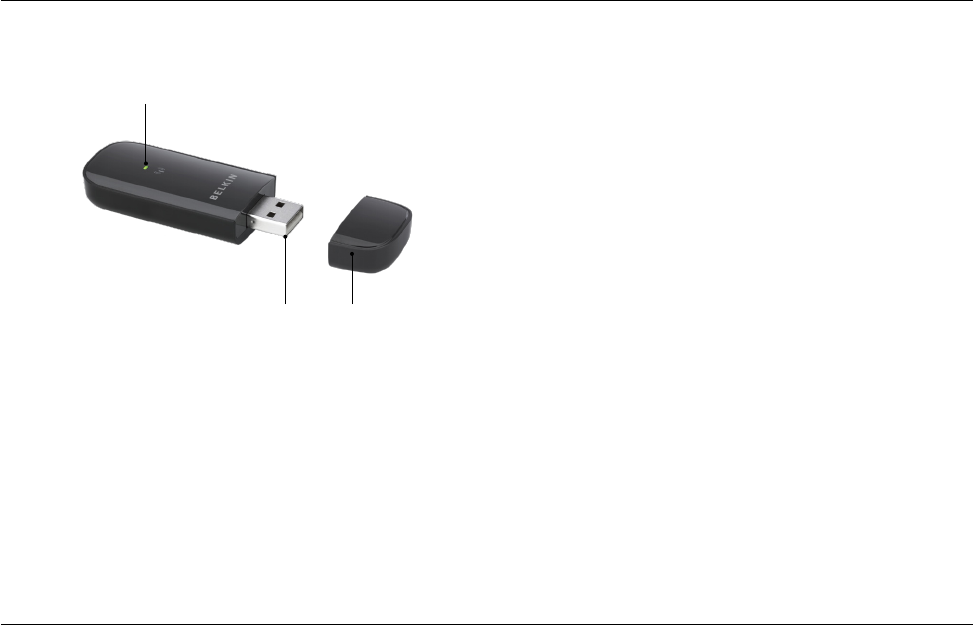
10
OVERVIEW
(a) Protective Cap
The cap is provided to protect the USB connector
during transportation. Remove the cap before inserting
the Adapter to your computer’s USB port.
(b) Power/Activity LED
Lights when the Adapter is powered on and flashes when it is active.
(c) USB Connector
Part of the Adapter that fits into your computer’s USB port.
(b)
(a)(c)

11
OVERVIEW
System Requirements
• PC-compatible laptop with one available USB 2.0 bus-power port
• Windows® XP with SP2 or later, Windows Vista®, or Windows 7
Package Contents
• Basic Wireless USB Adapter
• Quick Installation Guide
• CD with Installation Software and User Manual
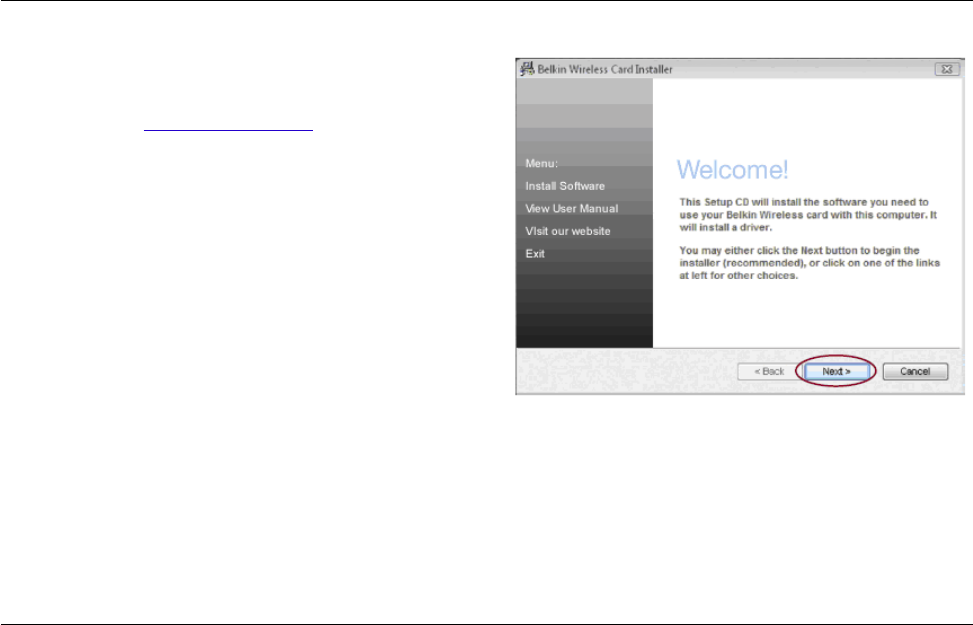
12
INSTALLING AND SETTING UP THE ADAPTER
A. Installation Process for Windows Vista and 7
NOTE: For information on updated drivers, please visit
the Belkin website at www.belkin.com/support.
IMPORTANT: INSTALL THE SOFTWARE
BEFORE INSERTING THE ADAPTER.
A.1 Insert the Installation Software CD into your CD-ROM drive.
A.2 Click “Next” to begin the installation process.
Note: If the Belkin Wireless Card Installer screen does not appear
within 20 seconds, access your CD-ROM by double-clicking on the
“My Computer” icon; then double-click on the CD-ROM drive into
which the installation CD has been placed. If the Installer does not
start automatically, double-click on the icon named “Installer.exe”.
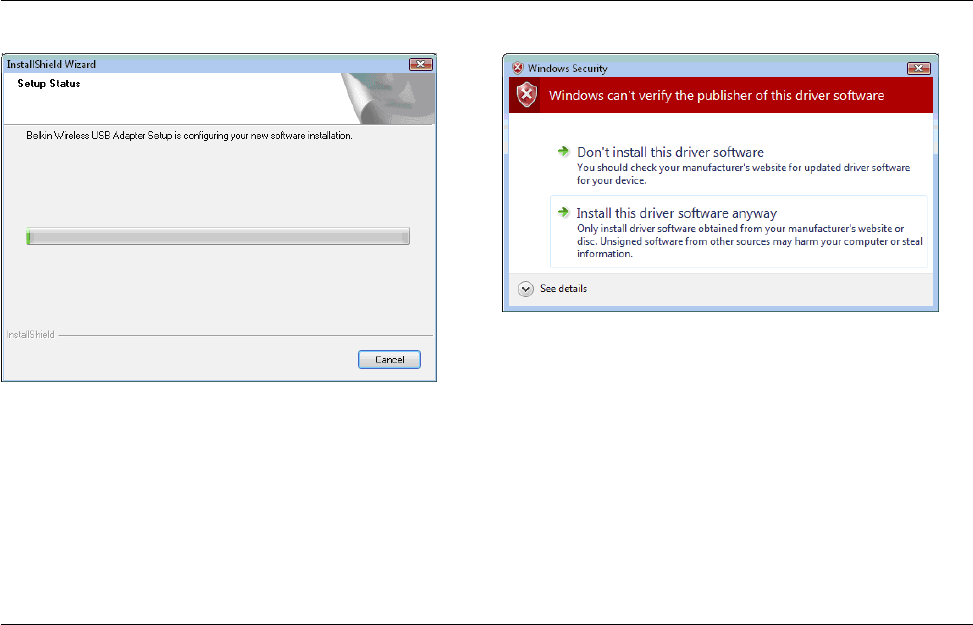
13
INSTALLING AND SETTING UP THE ADAPTER
A.3 The InstallShield Wizard will start the installation process. A.4 A window may appear showing the message, “Windows
can’t verify the publisher of this driver software”. This
DOES NOT indicate a problem. Our software has been
fully tested and is compatible with this operating system.
Click on “Install this driver software anyway” to continue.
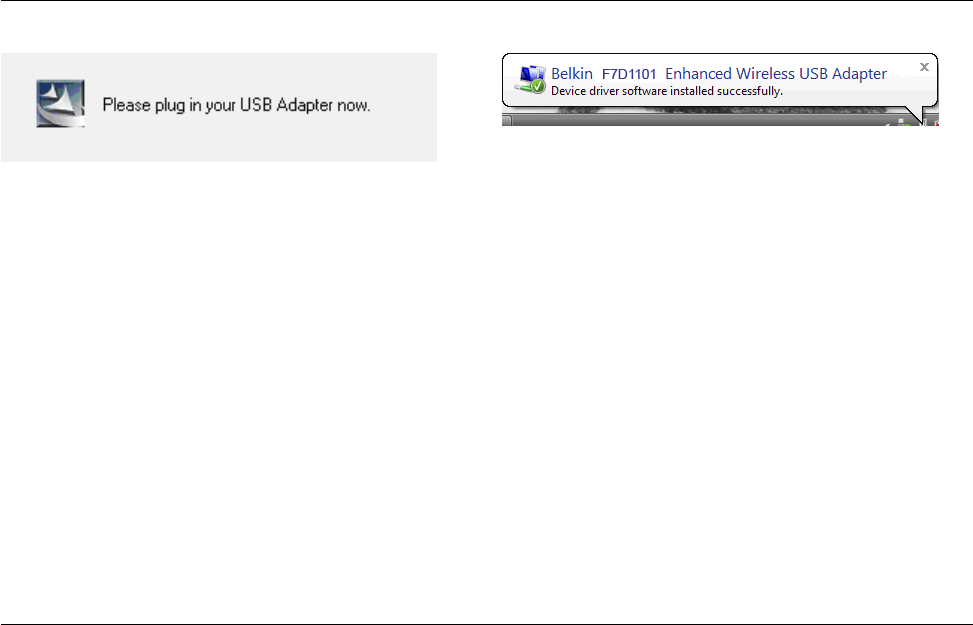
14
INSTALLING AND SETTING UP THE ADAPTER
A.5 When prompted, plug in your Adapter. A.6 When the installation completes, you will see the
following pop-up message on your Windows taskbar.
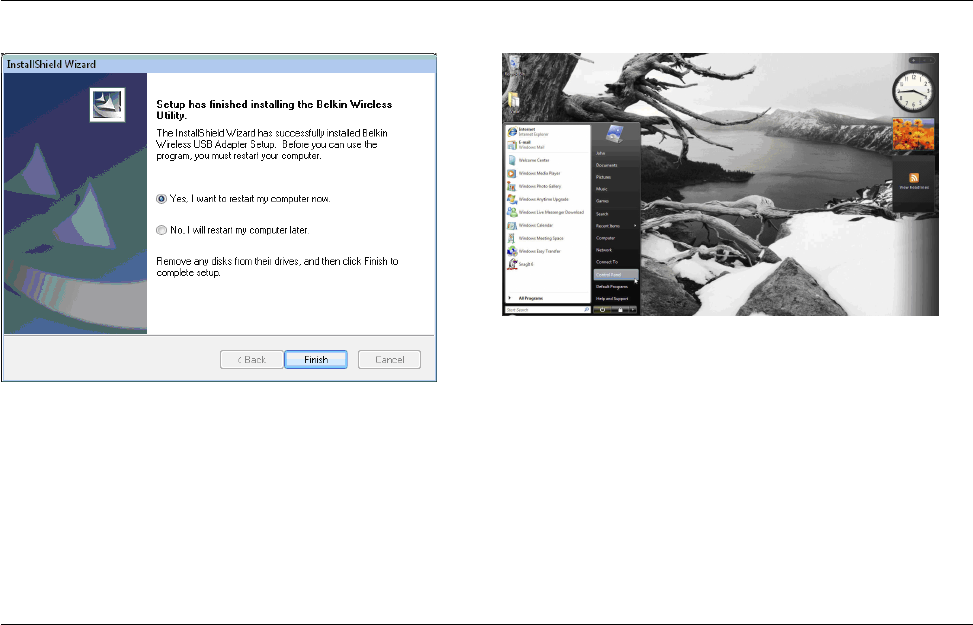
15
INSTALLING AND SETTING UP THE ADAPTER
A.7 Click “Finish” to restart your computer. A.8 To connect to the Internet, open the Network and Sharing Center
by first opening the Control Panel from the “Start” menu.
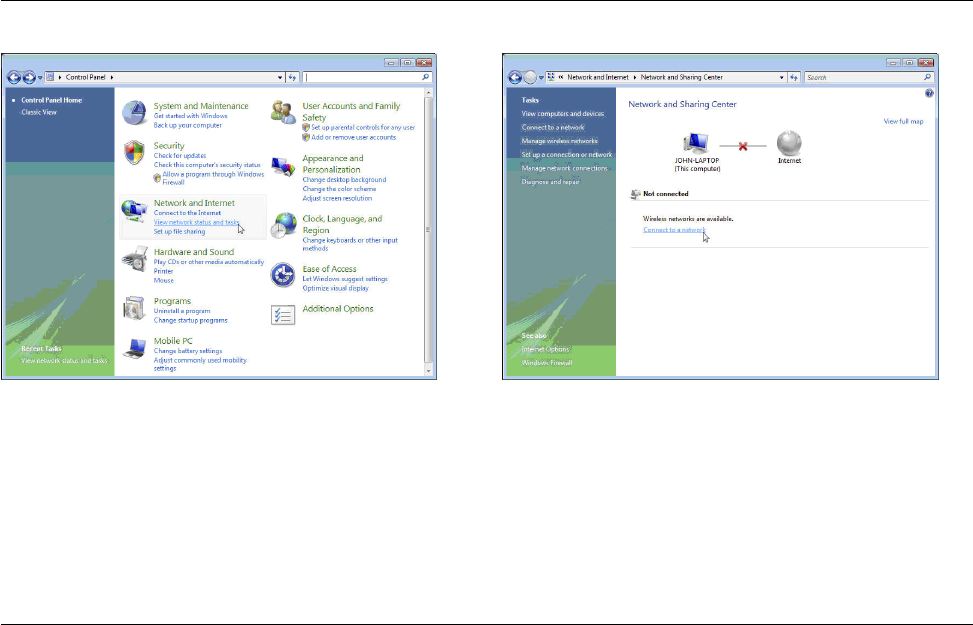
16
INSTALLING AND SETTING UP THE ADAPTER
A.9 In the Control Panel, click on “View network status and tasks”. A.10 In the Network and Sharing Center, click
on “Connect to a network”.
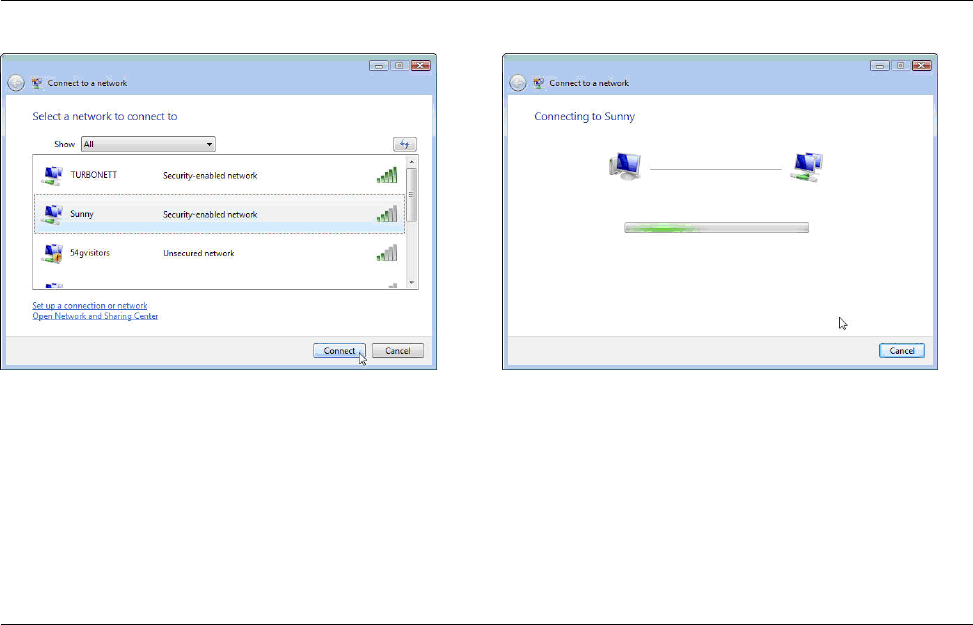
17
INSTALLING AND SETTING UP THE ADAPTER
A.11 In the next screen, select an available
wireless network and click “Connect”.
A.12 Your Adapter will attempt to connect to the selected network.
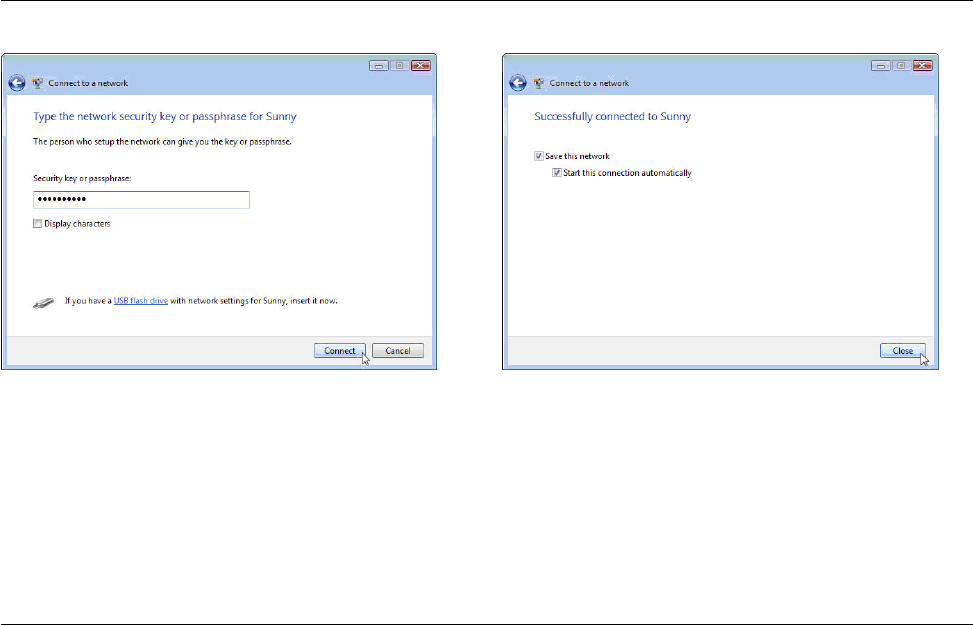
18
INSTALLING AND SETTING UP THE ADAPTER
A.13 Depending on the security settings of your wireless network,
you may be prompted to enter a network security key or a
passphrase. Click “Connect” after you have done so.
A.14 After connecting to the network, you can choose
to save this network and connect automatically
when your Adapter is in range.

19
INSTALLING AND SETTING UP THE ADAPTER
A.15 The Network and Sharing Center now indicates the network
connection that you have just established. The links on the left
of the window allow you to configure your network connections.
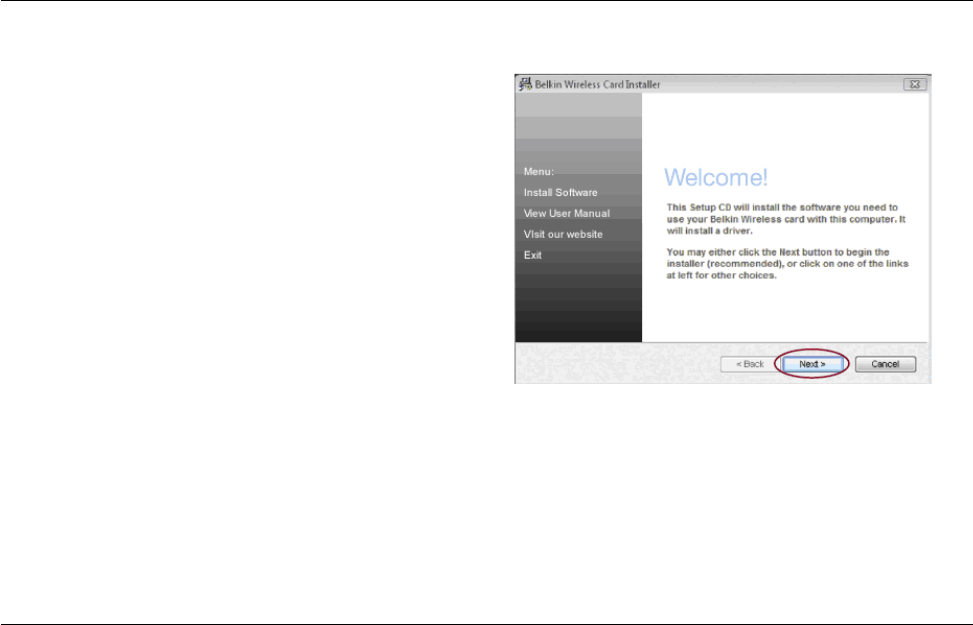
20
INSTALLING AND SETTING UP THE ADAPTER
B. Installation Process for Windows XP
IMPORTANT: INSTALL THE SOFTWARE
BEFORE INSERTING THE ADAPTER.
B.1 Insert the Installation Software CD into your CD-ROM drive.
B.2 The Belkin Wireless Adapter Installer screen will
automatically appear within up to 20 seconds. Click
“Install Software” or “Next” to start the installation.
Note: If the Belkin Wireless Adapter Installer screen does not
appear within 20 seconds, access your CD-ROM by double-
clicking on the “My Computer” icon; then double-click on the
CD-ROM drive into which the installation CD has been placed.
Then, double-click on the icon named “Installer.exe”.
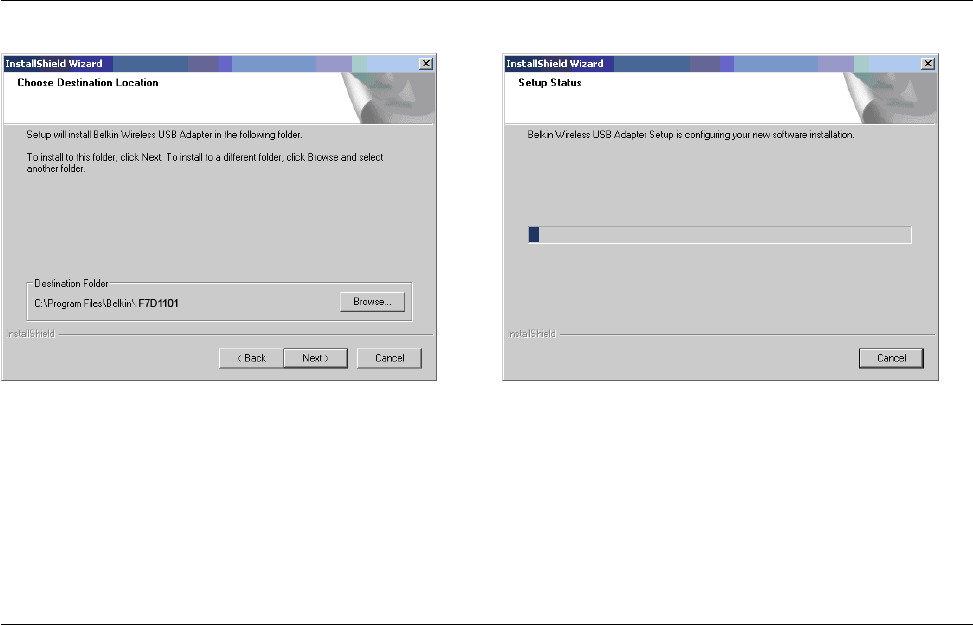
21
INSTALLING AND SETTING UP THE ADAPTER
B.3 Select a destination folder for the software installation by clicking
“Browse”; or, simply click “Next” to install to the default location.
B.4 A Setup Status screen lets you know where
you are in the setup process.
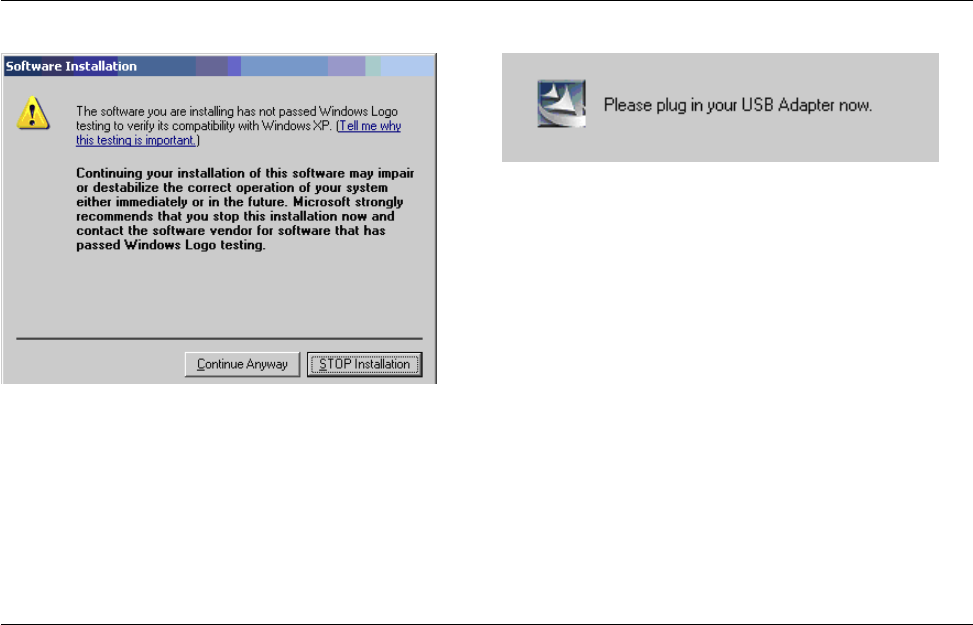
22
INSTALLING AND SETTING UP THE ADAPTER
B.5 A window may appear showing the message, “The software
you are installing…” This DOES NOT indicate a problem. Our
software has been fully tested and is compatible with this
operating system. Click on “Continue Anyway” to continue.
B.6 When prompted, plug in your Adapter.
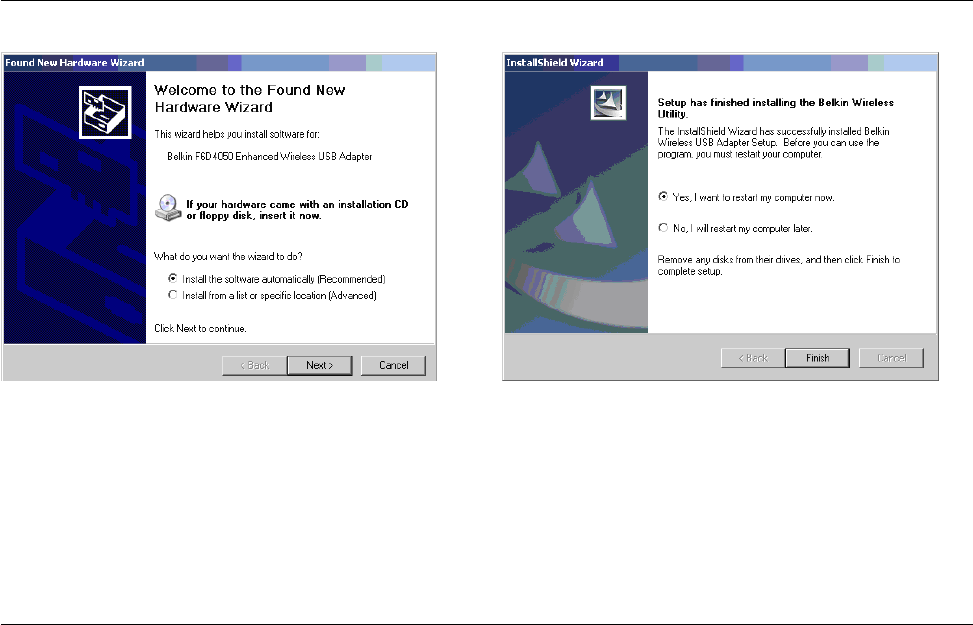
23
INSTALLING AND SETTING UP THE ADAPTER
B.7 The Found New Hardware Wizard might appear in
3–15 seconds. If it does, select “Install the software
automatically” and click “Next” to install the software.
B.8 Click “Finish” to restart your computer.

24
INSTALLING AND SETTING UP THE ADAPTER
Connecting to a Secure Wi-Fi® Network
If you choose to connect to a secure network,
determine the type of security (WPA/WPA2 or WEP)
and use the appropriate field in the dialog box.
Wireless Equivalent Privacy (WEP) is a less secure, but
more widely adopted wireless security protocol. Depending
on the security level (64- or 128-bit), the user will be
asked to input a 10- or 26-character hex key. A hex key
is a combination of letters, a–f, and numbers, 0–9.
Wi-Fi Protected Access® (WPA®/WPA2®) is the new standard
in wireless security. Instead of a hex key, WPA/WPA2 uses only
passphrases, which are much easier to remember. The passphrase
is 8–63 characters and can consist of alphabet letters and numbers.

25
TROUBLESHOOTING
I can’t connect to the Internet wirelessly.
If you are unable to connect to the Internet from a wireless
computer, please check the following items:
Look at the lights on your wireless router. If you’re using a
Belkin Wireless Router, the lights should be as follows:
• The “Power” light should be on and not blinking.
If this is NOT the case, make sure:
• The router’s power cord is plugged in.
• All cables are connected between the router and the modem.
• All the modem’s LEDs are functioning correctly.
If not, see your modem’s user manual.
• Reboot the router.
• Reboot the modem.
If you continue to have issues, please
contact Belkin Technical Support.
If you are not using a Belkin Wireless Router, consult
that router manufacturer’s user guide.
Power LED does not come ON; Adapter is not working.
If the LED indicators are not ON, the problem may be that the Adapter
is not connected or installed properly. Verify that the Adapter is
plugged firmly into the USB port of your computer. Check to see that
the drivers for the Adapter have been installed. Right-click on the “My
Computer” icon on your desktop. Choose “Properties” and navigate
to the “Device Manager” and see if your USB Adapter is listed without
any errors. If an error is indicated, contact Belkin Technical Support.

26
TROUBLESHOOTING
Link LED is blinking slowly; I cannot connect
to a wireless network or the Internet.
If your Adapter appears to be functioning properly, but you cannot
connect to a network or you have a red wireless icon at the bottom of
your screen, the problem may be that there is a mismatch between the
network name (SSID) settings in your wireless network properties.
Check the SSID settings to see if they match. The SSID
is case-sensitive and the spelling on each computer
must be exactly the same in order for the Adapter to
connect to the wireless router (or access point).
Note: To check the SSID settings or look for an available
network, double-click the Signal Indicator icon to bring up the
“Wireless Networks” screen. Click “Add” if you do not see the
network you are trying to connect to and type in the SSID.
For more information about setting up an SSID, please reference
your router manufacturer’s user manual. If issues persist even
at close range, please contact Belkin Technical Support.
Link LED is solid but I cannot connect to the Internet.
If you have a signal but can’t get online or obtain an IP address, the
problem may be that there is a mismatch between the encryption
key settings in your computer and wireless router (or access point).
Check the WEP, WPA, or WPA2 key settings to see if they match.
The key is case-sensitive and the spelling on each computer and
wireless router (or access point) must be exactly the same in order
for the Adapter to connect to the router. For more information about
encryption, see the “Connecting to a Secure Wi-Fi Network” section.
If issues persist even at close range, please
contact Belkin Technical Support.

27
TROUBLESHOOTING
Data transfer is sometimes slow.
Wireless technology is radio-based, which means connectivity
and the throughput performance between devices decreases
when the distance between devices increases. Other factors that
will cause signal degradation (metal is generally the worst culprit)
are obstructions such as walls and metal appliances. As a result,
the typical indoor range of your wireless devices will be between
100 to 200 feet. Note also that connection speed may decrease
as you move farther from the wireless router (or access point).
In order to determine if wireless issues are related to range, we
suggest temporarily moving the computer, if possible, to five to
10 feet away from the wireless router (or access point). Please
see the section titled, “Placement of your Wireless Networking
Hardware for Optimal Performance.” If issues persist even at
close range, please contact Belkin Technical Support.
Signal strength is poor.
Wireless technology is radio-based, which means connectivity
and the throughput performance between devices decreases
when the distance between devices increases. Other factors
that will cause signal degradation (metal is generally the worst
culprit) are obstructions such as walls and metal appliances. As
a result, the typical indoor range of your wireless devices will be
between 100 to 200 feet. Note also that connection speed may
decrease as you move farther from the wireless router (or access
point). In order to determine if wireless issues are related to
range, we suggest temporarily moving the computer, if possible,
to five to 10 feet away from wireless router (or access point).
Changing the wireless channel – Depending on local wireless
traffic and interference, switching the wireless channel of your
network can improve performance and reliability. The default channel
the router is shipped with is channel 6. You may choose from several
other channels depending on your region; see your router’s (or access
point’s) user manual for instructions on how to choose other channels.

28
TROUBLESHOOTING
Limiting the wireless transmit rate – Limiting the wireless transmit
rate can help improve the maximum wireless range, and connection
stability. Most wireless cards have the ability to limit the transmission
rate. To change this property, go to the Windows Control Panel,
open “Network Connections” and double-click on your Adapter’s
connection. In the “Properties” dialog, select the “Configure” button
on the “General” tab (Windows 98 users will have to select the USB
Adapter in the list box and then click “Properties”), then choose the
“Advanced” tab and select the rate property. Wireless client cards
are usually set to automatically adjust the wireless transmit rate for
you, but doing so can cause periodic disconnects when the wireless
signal is too weak; as a rule, slower transmission rates are more
stable. Experiment with different connection rates until you find the
best one for your environment; note that all available transmission
rates should be acceptable for browsing the Internet. For more
assistance, see your wireless card’s literature. If issues persist
even at close range, please contact Belkin Technical Support.
The Adapter does not perform or connection is unstable
when computer has a second built-in wireless network
card (such as a mini PCI or Intel® Centrino™).
This condition occurs if your computer has a built-in
wireless card while your Belkin Basic Wireless USB
Adapter is also active. This happens because Windows
must now handle two active wireless connections.
You must disable the built-in wireless card from your computer
under “Network Adapters” in the Device Manager.

29
TROUBLESHOOTING
The Adapter does not perform or connection is slow
when computer has a built-in wired Ethernet card.
This condition occurs if your computer has an active Ethernet
card while your Adapter is also active. This happens because
Windows must now handle two active network connections.
You must disable the Ethernet card from your computer
under “Network Adapters” in the Device Manager.
What’s the difference between 802.11g and 802.11n?
Currently there are three commonly used wireless networking
standards, which transmit data at very different maximum
speeds. Each is based on the designation for certifying network
standards. The most common wireless networking standard,
802.11g, can transmit information up to 54Mbps; 802.11a
also supports up to 54Mbps, but in the 5GHz frequency;
and 802.11n specification can connect at up to 300Mbps.
See the following chart for more detailed information.

30
TROUBLESHOOTING
Belkin Wireless Comparison Chart
*Distance and connection speeds will vary depending on your networking environment.
Wireless
Technology
G
(802 .11g)
Basic
(1x1 802.11n)
Surf/Share N MIMO
802.11n
Play Dual-Band MIMO
802.11n
Speed/
Data Rate*
Up to 54Mbps* Up to 150Mbps* Up to 300Mbps* Up to 300Mbps*
Frequency Common household devices
such as cordless phones
and microwave ovens
may interfere with the
unlicensed band 2.4GHz
Common household devices
such as cordless phones
and microwave ovens
may interfere with the
unlicensed band 2.4GHz
Common household devices
such as cordless phones
and microwave ovens
may interfere with the
unlicensed band 2.4GHz
Uses both 2.4GHz and 5GHz
bands for less interference
and better throughput
Compatibility Compatible with 802.11b/g Compatible with 802.11b/g Compatible with 802.11n
and 802.11b/g
Compatible with 802.11n
and 802.11a/b/g
Coverage* Up to 400 ft.* Up to 1,000 ft.* Up to 1,200 ft.* Up to 1,400 ft.*
Advantage Common—widespread
use for Internet sharing
Better coverage and
consistent speed and range
Good speed and coverage Leading edge— best
coverage and throughput

31
TROUBLESHOOTING
Technical Support
US
http://www.belkin.com/support
UK
http://www.belkin.com/uk/support
Australia
http://www.belkin.com/au/support
New Zealand
http://www.belkin.com/au/support
Singapore
1800 622 1130
Europe
http://www.belkin.com/uk/support

32
FCC Statement
DECLARATION OF CONFORMITY WITH FCC RULES
FOR ELECTROMAGNETIC COMPATIBILITY
We, Belkin International, Inc., of 12045 Waterfront Drive, Los
Angeles, CA 90094, declare under our sole responsibility that the
product, F7D1101v1, to which this declaration relates, complies with
Part 15 of the FCC Rules. Operation is subject to the following two
conditions: (1) this device may not cause harmful interference,
and (2) this device must accept any interference received,
including interference that may cause undesired operation.
Federal Communications Commission Notice
This equipment has been tested and found to comply with the
limits for a Class B digital device, pursuant to Part 15 of the FCC
Rules. These limits are designed to provide reasonable protection
against harmful interference in a residential installation.
This equipment generates, uses, and can radiate radio frequency
energy and, if not installed and used in accordance with the
instructions, may cause harmful interference to radio communications.
However, there is no guarantee that interference will not occur
in a particular installation. If this equipment does cause harmful
interference to radio or television reception, which can be determined
by turning the equipment off and on, the user is encouraged to try
to correct the interference by one of the following measures:
• Reorient or relocate the receiving antenna.
• Increase the distance between the equipment and the receiver.
• Connect the equipment to an outlet on a circuit different
from that to which the receiver is connected.
• Consult the dealer or an experienced radio/TV technician for help.
INFORMATION
For product available in the USA/Canada market, only channel 1~11 can be
operated. Selection of other channels is not possible.
This device and its antenna(s) must not be co-located or operation in
conjunction with any other antenna or transmitter.
IMPORTANT NOTE:
Federal Communication Commission (FCC) Radiation Exposure Statement
This EUT is compliance with SAR for general population/uncontrolled
exposure limits in ANSI/IEEE C95.1-1999 and had been tested in
accordance with the measurement methods and procedures specified in
OET Bulletin 65 Supplement C. This equipment should be installed and
operated with minimum distance 1.5 cm between the radiator and your body.

33
INFORMATION
FCC Caution: Any changes or modifications not expressly
approved by the party responsible for compliance could
void the user’s authority to operate this equipment.
IMPORTANT NOTE:
Radiation Exposure Statement
This equipment complies with FCC radiation exposure limits set forth
for an uncontrolled environment. End users must follow the specific
operating instructions for satisfying RF exposure compliance. To
maintain compliance with FCC RF exposure compliance requirements,
please follow operation instructions as documented in this manual.
This transmitter must not be co-located or operating in
conjunction with any other antenna or transmitter.
SAR compliance has been established in typical laptop computer(s)
with USB slots, and this product could be used in typical laptop
computers with USB slots. Other applications, such as handheld
PCs or similar devices, have not been verified and may not comply
with related RF exposure rules and such use shall be prohibited.
The availability of some specific channels and/or operational
frequency bands is country-dependent and firmware is
programmed at the factory to match the intended destination.
The firmware setting is not accessible by the end user.
Modifications
The FCC requires the user to be notified that any
changes or modifications to this device that are not
expressly approved by Belkin International, Inc., may
void the user’s authority to operate the equipment.
Industry Canada Statement
This device complies with RSS-210 of the Industry Canada
Rules. Operation is subject to the following two conditions:
1) This device may not cause interference, and
2) This device must accept any interference, including interference
that may cause undesired operation of the device.
IMPORTANT NOTE:
IC Radiation Exposure Statement
This Class B digital apparatus complies with Canadian ICES-003.
Cet appareil numérique de la classe B conforme á la norme NMB-003 du Canada.
Operation is subject to the following two conditions: (1) this device may not cause
interference, and (2) this device must accept any interference, including
interference that may cause undesired operation of the device.
IMPORTANT NOTE:
This EUT is compliance with SAR for general population/uncontrolled exposure limits in
IC RSS-102 and had been tested in accordance with the measurement methods and
procedures specified in IEEE 1528. This equipment should be installed and operated
with minimum distance 1.5 cm between the radiator and your body.
For product available in the USA/Canada market, only channel 1~11 can be
operated. Selection of other channels is not possible. This device and its antenna
(s) must not be co-located or operation in conjunction with any other antenna or
transmitter.

34
INFORMATION
Belkin International, Inc., Limited
2-Year Product Warranty
What this warranty covers.
Belkin International, Inc. (“Belkin”) warrants to the original
purchaser of this Belkin product that the product shall be free
of defects in design, assembly, material, or workmanship.
What the period of coverage is.
Belkin warrants the Belkin product for two years.
What will we do to correct problems?
Product Warranty.
Belkin will repair or replace, at its option, any defective product
free of charge (except for shipping charges for the product).
Belkin reserves the right to discontinue any of its products without
notice, and disclaims any limited warranty to repair or replace any
such discontinued products. In the event that Belkin is unable to
repair or replace the product (for example, because it has been
discontinued), Belkin will offer either a refund or a credit toward
the purchase of another product from Belkin.com in an amount
equal to the purchase price of the product as evidenced on the
original purchase receipt as discounted by its natural use.
What is not covered by this warranty?
All above warranties are null and void if the Belkin product is not
provided to Belkin for inspection upon Belkin’s request at the sole
expense of the purchaser, or if Belkin determines that the Belkin
product has been improperly installed, altered in any way, or tampered
with. The Belkin Product Warranty does not protect against acts
of God such as flood, earthquake, lightning, war, vandalism, theft,
normal-use wear and tear, erosion, depletion, obsolescence, abuse,
damage due to low voltage disturbances (i.e. brownouts or sags), non-
authorized program, or system equipment modification or alteration.

35
INFORMATION
How to get service.
To get service for your Belkin product you
must take the following steps:
1. Contact Belkin International, Inc., at 12045 Waterfront
Drive, Los Angeles, CA 90094, Attn: Customer Service,
or call (800)-223-5546, within 15 days of the Occurrence.
Be prepared to provide the following information:
a. The part number of the Belkin product.
b. Where you purchased the product.
c. When you purchased the product.
d. Copy of original receipt.
2. Your Belkin Customer Service Representative will then
instruct you on how to forward your receipt and Belkin
product and how to proceed with your claim.
Belkin reserves the right to review the damaged Belkin product.
All costs of shipping the Belkin product to Belkin for inspection
shall be borne solely by the purchaser. If Belkin determines,
in its sole discretion, that it is impractical to ship the damaged
equipment to Belkin, Belkin may designate, in its sole discretion,
an equipment repair facility to inspect and estimate the cost to
repair such equipment. The cost, if any, of shipping the equipment
to and from such repair facility and of such estimate shall be
borne solely by the purchaser. Damaged equipment must remain
available for inspection until the claim is finalized. Whenever
claims are settled, Belkin reserves the right to be subrogated
under any existing insurance policies the purchaser may have.

36
INFORMATION
How state law relates to the warranty.
THIS WARRANTY CONTAINS THE SOLE WARRANTY OF
BELKIN. THERE ARE NO OTHER WARRANTIES, EXPRESSED
OR, EXCEPT AS REQUIRED BY LAW, IMPLIED, INCLUDING
THE IMPLIED WARRANTY OR CONDITION OF QUALITY,
MERCHANTABILITY OR FITNESS FOR A PARTICULAR
PURPOSE, AND SUCH IMPLIED WARRANTIES, IF ANY, ARE
LIMITED IN DURATION TO THE TERM OF THIS WARRANTY.
Some states do not allow limitations on how long an implied
warranty lasts, so the above limitations may not apply to you.
IN NO EVENT SHALL BELKIN BE LIABLE FOR INCIDENTAL,
SPECIAL, DIRECT, INDIRECT, CONSEQUENTIAL OR
MULTIPLE DAMAGES SUCH AS, BUT NOT LIMITED TO,
LOST BUSINESS OR PROFITS ARISING OUT OF THE
SALE OR USE OF ANY BELKIN PRODUCT, EVEN IF
ADVISED OF THE POSSIBILITY OF SUCH DAMAGES.
This warranty gives you specific legal rights, and you may also have
other rights, which may vary from state to state. Some states do
not allow the exclusion or limitation of incidental, consequential,
or other damages, so the above limitations may not apply to you.
